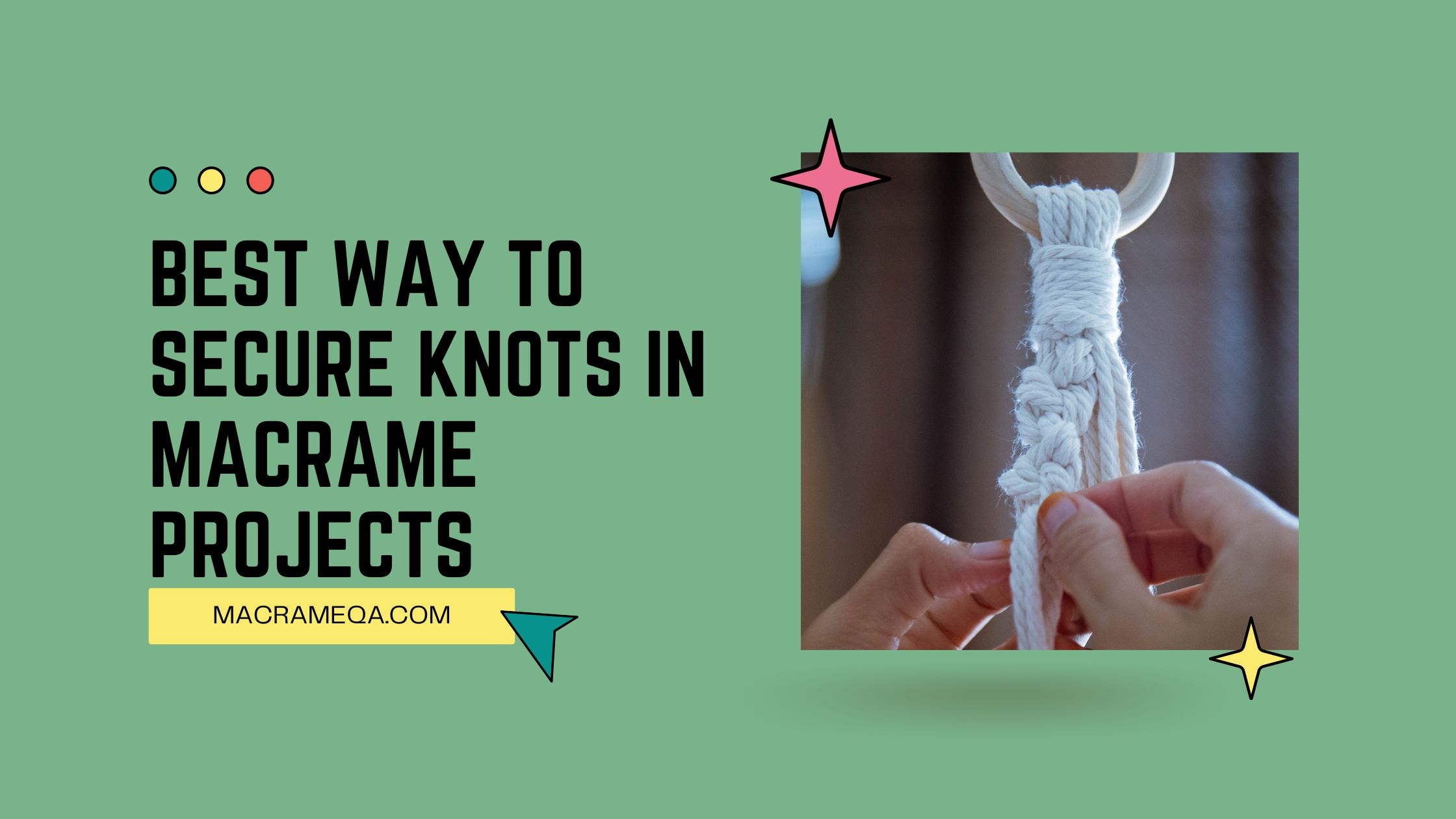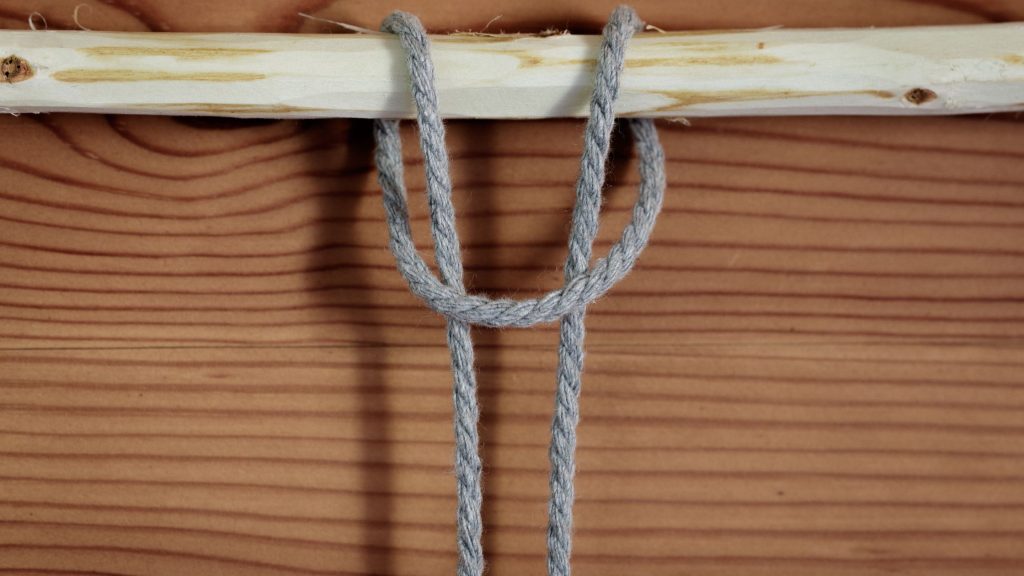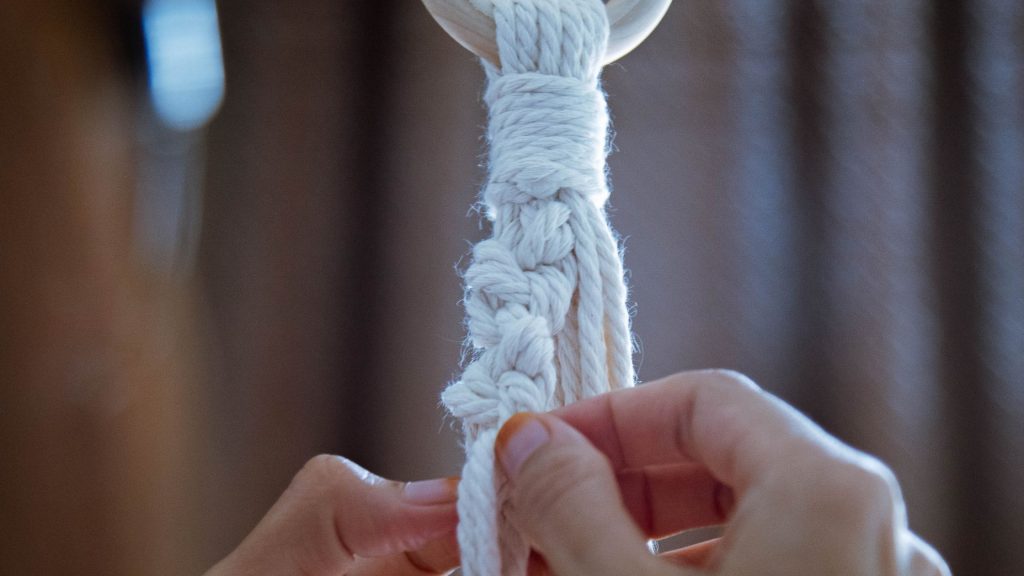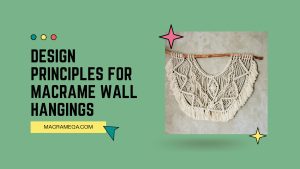Macrame projects have gained popularity in recent years due to their intricate designs and unique charm. However, one of the biggest challenges that macrame enthusiasts face is securing knots in their projects. Whether you’re a beginner or a seasoned crafter, finding the best way to ensure that your knots stay put is essential for a successful macrame project. In this article, we will explore some tried and tested techniques to help you achieve perfectly secure macrame knots. So, grab your supplies and let’s dive into the world of macrame knot security!
Best Way To Secure Macrame Knots
Explore different types of knots in macrame, factors to consider when choosing a knot, and techniques for securing knots.
First, let’s take a look at some of the different types of macrame knots commonly used:
Square knot
The square knot is one of the most fundamental knots in macrame. It is created by crossing two strands of cord and then tying them in a simple over-and-under pattern. The square knot is great for creating a flat, woven pattern in your macrame projects.
Half hitch knot
The half hitch knot is another basic knot in macrame. It is created by making a loop with one strand of cord and then pulling the other strand through the loop. This knot is often used to create patterns or add decorative elements to macrame designs.
Double half hitch knot
The double half hitch knot is a variation of the half hitch knot. Instead of making a single loop, you make two loops and pull the second strand through both loops. This knot is often used to create diagonal or chevron patterns in macrame.
Larks head knot
The larks head knot is a simple knot that is used to attach cord to a ring, dowel, or other base for your macrame project. It is created by folding a strand of cord in half, placing the folded end over the base, and pulling the loose ends through the folded loop.
Clove hitch knot
The clove hitch knot is another knot that is used to attach cord to a base. It is created by crossing one strand of cord over the base, crossing the other strand over the first, and then pulling the second strand under the first and through the loop created.
Josephine knot
The Josephine knot is a decorative knot that is often used as a focal point in macrame designs. It is created by making a series of loops with one strand of cord and then weaving the other strand through the loops to create a knot.
Alternating square knot
The alternating square knot is a variation of the square knot that creates a zigzag pattern. It is created by alternating the direction of the knots in each row.
Fishnet knot
The fishnet knot is a decorative knot that creates a net-like pattern. It is created by making a series of loops with one strand of cord and then weaving the other strand in and out of the loops.
Berry knot
The berry knot is a decorative knot that resembles a cluster of berries. It is created by making a series of loops with one strand of cord and then weaving the other strand through the loops to create a knot.
Overhand knot
The overhand knot is a simple knot that is often used as a stopper knot or to create a loop at the end of a piece of cord. It is created by making a loop with the cord and then pulling the end through the loop.
Factors to Consider When Choosing a Knot
Now that we’ve explored some of the different types of knots in macrame, let’s discuss the factors to consider when choosing a knot for your project:
Strength
One of the most important factors to consider when choosing a knot is its strength. You want to make sure that the knot will hold up over time and not come undone easily. Different knots have different levels of strength, so it’s important to choose a knot that is appropriate for the weight and tension of your project.
Appearance
Another factor to consider when choosing a knot is its appearance. Some knots create a simple, clean look, while others create more intricate patterns or designs. Consider the overall aesthetic of your project and choose a knot that complements it.
Ease of untying
Depending on the nature of your project, you may need to untie the knots at some point. Consider how easy or difficult it will be to untie the knot and choose accordingly. Some knots, like the overhand knot, are quick and easy to untie, while others, like the square knot, may require more effort.
Suitability for the project
Not all knots are suitable for every project. Consider the specific requirements of your project, such as the type of cord you’re using or the size of the base, and choose a knot that is appropriate for those factors.
Personal preference
Finally, don’t forget to consider your personal preference when choosing a knot. Ultimately, you want to choose a knot that you enjoy creating and that you’re happy with the look of in your project.
Now that you’ve chosen the perfect knot for your macrame project, it’s time to secure it. There are several techniques you can use to ensure that your knots stay in place:
Adding extra knots
One simple way to secure your knots is to add extra knots on top of them. For example, if you’ve tied a square knot, you can tie another square knot on top of it to reinforce it.
Using glue or adhesive
Another technique for securing knots is to use glue or adhesive. Apply a small amount of glue or adhesive to the knot and let it dry completely. This will help to keep the knot in place and prevent it from coming undone.
Melting the ends
If you’re working with a synthetic cord, such as nylon or polyester, you can use a lighter to melt the ends of the cord after tying the knot. This will create a seal that prevents the knot from unraveling.
Whipping the ends
Whipping the ends of the cord is another way to secure knots. This involves wrapping a separate piece of cord tightly around the ends of the cord near the knot, creating a neat and secure finish.
Using wax or thread conditioner
Applying wax or thread conditioner to the ends of the cord can help to prevent the knots from coming undone. Simply rub a small amount of wax or conditioner onto the ends of the cord before tying the knot.
Using a fabric stiffener
If you’re working with a cord that is prone to fraying, you can use a fabric stiffener to secure the ends of the cord. Apply a small amount of fabric stiffener to the ends of the cord and let it dry before tying the knot.
Using clear drying fabric glue
Similar to using glue or adhesive, you can also use clear drying fabric glue to secure the ends of the cord. Apply a small amount of glue to the ends of the cord and let it dry before tying the knot.
Applying heat shrink tubing
Heat shrink tubing is another option for securing knots. Simply slide a small piece of heat shrink tubing onto the cord, position it near the knot, and then heat it with a heat gun or lighter. The tubing will shrink and secure the knot in place.
Sewing the ends
For a more permanent and secure finish, you can sew the ends of the cord after tying the knot. Use a needle and thread that matches the color of the cord and stitch through the ends of the cord several times to reinforce the knot.
How To Secure Specific Macrame Knots
Now that you know some techniques for securing knots, let’s go over how to secure specific knots in macrame:
How to Secure Square Knots
To secure square knots, you can use many of the techniques mentioned above. Adding extra knots, using glue or adhesive, melting the ends, whipping the ends, using wax or thread conditioner, using a fabric stiffener, using clear drying fabric glue, applying heat shrink tubing, or sewing the ends are all viable options.
How to Secure Half Hitch Knots
Similarly, you can use the same techniques to secure half hitch knots. Adding extra knots, using glue or adhesive, melting the ends, whipping the ends, using wax or thread conditioner, using a fabric stiffener, using clear drying fabric glue, applying heat shrink tubing, or sewing the ends will help to keep your half hitch knots secure.
How to Secure Double Half Hitch Knots
The same techniques can be applied to secure double half hitch knots. Adding extra knots, using glue or adhesive, melting the ends, whipping the ends, using wax or thread conditioner, using a fabric stiffener, using clear drying fabric glue, applying heat shrink tubing, or sewing the ends will all help to secure your double half hitch knots.
How to Secure Larks Head Knots
To secure larks head knots, you can again use the techniques mentioned above. Adding extra knots, using glue or adhesive, melting the ends, whipping the ends, using wax or thread conditioner, using a fabric stiffener, using clear drying fabric glue, applying heat shrink tubing, or sewing the ends will keep your larks head knots in place.
How to Secure Clove Hitch Knots
The techniques for securing clove hitch knots are the same as those mentioned above. Adding extra knots, using glue or adhesive, melting the ends, whipping the ends, using wax or thread conditioner, using a fabric stiffener, using clear drying fabric glue, applying heat shrink tubing, or sewing the ends will all ensure that your clove hitch knots stay secure.
How to Secure Josephine Knots
To secure Josephine knots, you can use a combination of the techniques mentioned above. Adding extra knots, using glue or adhesive, melting the ends, whipping the ends, using wax or thread conditioner, using a fabric stiffener, using clear drying fabric glue, applying heat shrink tubing, or sewing the ends will help to keep your Josephine knots in place.
How to Secure Overhand Knots
Finally, securing overhand knots can be done using the same techniques mentioned above. Adding extra knots, using glue or adhesive, melting the ends, whipping the ends, using wax or thread conditioner, using a fabric stiffener, using clear drying fabric glue, applying heat shrink tubing, or sewing the ends will all ensure that your overhand knots are secure.
Conclusion
In conclusion, there are many different types of knots used in macrame, each with its own characteristics and uses. When choosing a knot, consider factors like strength, appearance, ease of untying, suitability for the project, and personal preference. Once you’ve selected the perfect knot, use techniques like adding extra knots, using glue or adhesive, melting the ends, whipping the ends, using wax or thread conditioner, using a fabric stiffener, using clear drying fabric glue, applying heat shrink tubing, or sewing the ends to secure your knots. With the right knot and secure techniques, your macrame projects will not only look beautiful but stand the test of time. Now go ahead and create something amazing!











